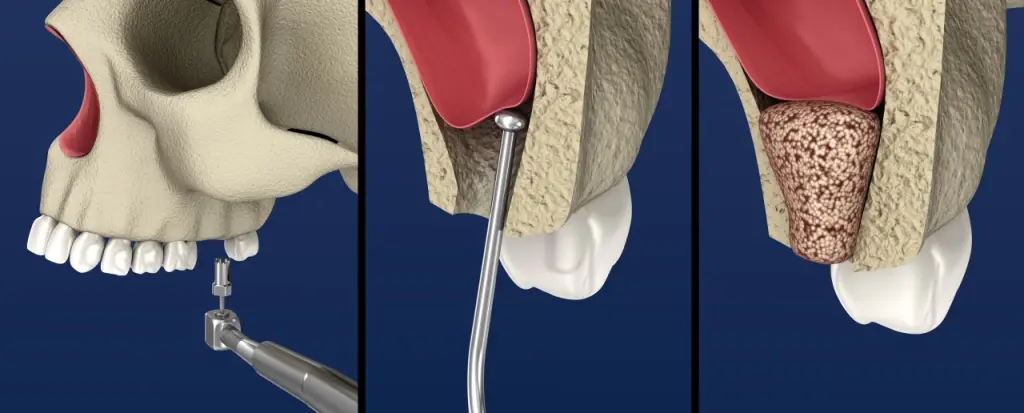Dental implants are ideal for patients who have one or more missing teeth. Recent studies reveal that there are about 5 million implant procedures done by dentists in the United States annually. Some situations may require additional treatments before an implant can be placed. One such recommended treatment is a sinus lift. In this post, we will focus on when a sinus lift is appropriate and its benefits.
What Is a Sinus Lift/Sinus Augmentation?
A person undergoes a sinus lift when they need dental implants but do not have enough jaw bone to secure the implants due to bone loss. The surgery increases the volume of bone by adding bone to the space between the molars and premolars. During the procedure, the sinus membrane is moved upward to make room for the bone.
Why You May Need a Sinus Lift
There are a few reasons why someone may need a sinus lift. Some of these reasons include the following.
If Your Maxillary Sinus Is Too Close
Before you get implants in your upper jaw, you need adequate bone density. A maxillary sinus that is too close to the upper jaw increases the risk of implant penetration. To avoid such risks, a sinus lift surgery adds to and reinforces the bone so the implant can set securely.
Tooth Loss
Your teeth do more than chew your food, they also support your jaw bone. Losing a tooth can lead to bone deterioration over time. If you lost a tooth a long time ago, the thickness of bone between the sinus could have changed. In such a scenario, you may need a sinus lift to increase bone mass before a dental implant is set.
Untreated Tooth Decay
If you have tooth decay that goes untreated, the decay could spread to the bone. This decay ultimately weakens the bone and makes it unsuitable for an implant. This is another scenario where a sinus lift will provide adequate reinforcement before placing an implant.
Periodontal Disease
Patients who suffer from periodontal disease may need a sinus lift before an implant. According to the CDC, 47.2 percent of adults aged 30 years and older in the USA live with periodontal disease. The condition typically affects the jaws leading to an extensive amount of bone loss.
What Happens Before, During, and After a Sinus Lift?
Before a Sinus Lift
A sinus lift involves transferring a bone to your upper jaw. The first step in the procedure is to determine the source of the bone for the surgery. Some of the common types of bone used in sinus augmentation include:
- An autogenous bone usually taken from an area of your mouth
- A synthetic bone-like material
Once the bone source is identified, Dr. Trujillo will study your jaw and sinus anatomy to establish its condition. Accurate measurements are also taken to determine the width and height of your existing bone. X-rays or computed tomography scans will allow Dr. Trujillo to assess your overall jaw health and other vital skull structures.
During the Procedure
There are several approaches to sinus lift surgery. The right technique for you depends on several factors, including the type of bone graft and how much bone you currently have in your jaw. Some of the basic steps include:
- Receiving intravenous or oral sedatives to numb the area and keep you as comfortable as possible during the procedure
- Incisions on the back parts of your gum tissue to expose the bone
- Cut a small area of the bone while taking necessary precautions not to cut the sinus membranes
- Lift the cut portion of the bone up into the sinus cavity to raise the membrane
- Apply bone graft materials on the lifted area before applying sutures to close the incisions in your gums
After the Surgery
Following the procedure, the dental specialist will provide instructions that guide your recovery. You may experience some side effects, including swelling and bleeding. However, this discomfort rarely lasts a few days. For a quick and successful recovery, your doctor may recommend that you:
- Don’t smoke as this impairs your healing time
- Avoid brushing teeth for a specific time to prevent dislodging clots
- Avoid vigorous blowing of nose and sneezing
- Do not use a straw as this may dislodge clots
- Take antibiotics to prevent infections
- Take pain relievers to relieve discomfort
Usually, you need a checkup one week after the procedure. During this appointment, the Dr. Trujillo will examine the surgical site and remove any stitches that have not dissolved on their own. However, if you experience any pain that keeps worsening or have uncontrollable bleeding, don’t wait. Call Dr. Trujillo right away.
How Long Does It Take for a Sinus Lift to Heal Completely?
Full recovery after a sinus lift surgery takes a minimum of 6 months. During this time the sinus will heal and the bone will become strong enough for a dental implant. Although this process seems slow, remember the benefits last a lifetime.
How Much Does a Sinus Lift Cost?
The average cost of a sinus augmentation can be between $1500 and $5000, depending on the complexity of the procedure. If the bone graft material is large, the cost is typically higher. It is important to work with a thorough and qualified expert, like Dr. Trujillo to get the most out of your investment.
Are There Risks with Sinus Lift Surgery?
With all surgery comes certain risks. A procedure performed by a qualified and experienced periodontal surgeon decreases the amount of risks. The most significant risk of this surgery is the possibility of piercing or tearing the sinus membrane. However, should this happen, it will be immediately repaired. Another risk is a sinus infection. However, with the proper medication, this is easily preventable.
Contact the Right Periodontal Surgeon
If you have questions about a sinus lift, our highly experienced periodontal surgical team can answer your questions. We can guide you through every step and ensure you get the smile you have always wanted. Contact us today to schedule a consultation.

Let’s Answer All of Your Questions
Call Dr. Trujillo in Phoenix, AZ, for a personalized consultation about sinus lifts and dental implants! We want you to feel confident and smile your best. Call today!





